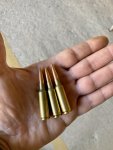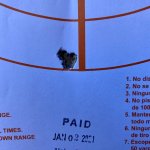I have a pound of N555, but haven't shot it as of yet. In my 300 WM and my prototype 153 gr bullet, which favors the faster side of the 4350 burn range due to the thicker Gunwerks brass used, low friction, and a long tail, I started with N550 as I thought N555 would be a tad too slow when compared to prior RL16 and H4350 results and in speaking with VV directly. All my VV powders are newer lots from late summer of last year during the buying frenzy that occurred then.
I had high hopes for this combo. I simply shot a four shot workup at a temp of 64F, moving up one grain with each shot, extrapolating data from different resources as load data for the 300WM and a 150-155 gr class bullet isn't available for N550 (or N555). This first iteration was just to get a gage of where this powder was at with this combo. Velocity was acceptable, not earth shattering, but acceptable (top end was 3402 fps). I hit the upper end of what I'd consider my personal threshold on pressure in the load up sequence, and it is well below when pressure indicators exist (I have a pressure sensing system to gage actual pressure over time, see graphs below). I actually didn't expect to see pressures that high in the first four shot workup, but velocities were what I would have expected, so, in combination, that was a bit of a downer. Several problems existed as can be observed from the wild pressure traces in the graph. The most prominent is the secondary spike towards the end. While there are many things that can create this phenomenon, two things typically contribute to this, a double-based powder, and a powder too slow for the combination. In this instance, top end case fill was probably only 97% and it was a tad higher pressure than what I'd like to run for a hunting combination, so if anything, it was on the faster side for that combo. The double-based nature of the powder is probably not doing me any favors in this particular instance, but isn't necessarily the only reason as previously mentioned. The low friction plays a role for sure, but low friction is a good thing for increased velocity and reduced barrel fouling and heat in general. In summary, "large case - light bullet" in a moderate overbore like the 300 WM, I wouldn't recommend N550, or probably N555. With a small case and heavy bullet, like the 308 Win, or possibly even the 6.5 Creedmoor shooting heavy pills, probably a completely different story.
300WM - Gunwerks - N550 - 153gr - 64F
Back to the N550 work up, the group on paper wasn't fantastic, and the muzzle exit times (crosshairs) from the graph correlate with that. Yes, these were all at incrementally higher charge weights, but the beginning of the ignition phase was inconsistent, which then really destroys the rest of the timing out the muzzle. The bullets were substantially crimped with a collet crimp die and far off the lands, so this area, the ignition phase itself, should be very consistent, in general, and up to about 7 ksi, they all ran together, which is about where the bullet started to release. I've also attached two work up loads, one for H4350 and the other IMR4350, as a comparison to show what I mean for a consistent profile.
300WM - Gunwerks - H4350 - 153gr - 89F
300WM - Gunwerks - IMR4350 - 153gr - 89F

Not to veer off the VV subject too far, but also attached is RL16, from two different days, both identical work up loads as well. I missed the first shot on the hot day, so it only has three showing. Don't correlate the colors between the two, but rather look at last charge weights and work upwards, graph to graph. Any of you ever wonder why when doing temp sensitivity studies on RL16, some have reported a decent jump from low temp to mid temp, then at high temp, the velocity goes LOWER again? So the total spread from low to high is very low, but it looks like a bell curve, not a regression line. Well, as far as combustion dynamics are concerned, I can at least show what's going on, even if I can't explain it. Strange indeed, and has made me move away from RL16 for this combo as well. Unfortunate too, as at 3450 FPS, it had real potential in 90F heat. It wasn't as consistent as IMR or H, but it was a bit more consistent than shown below when loaded to the same charge weights. It was around 3470 FPS at 64F with mediocre groups.
300WM - Gunwerks - RL16 - 153gr - 89F
300WM - Gunwerks - RL16 - 153gr - 64F

 outdoors.natchezss.com
outdoors.natchezss.com







